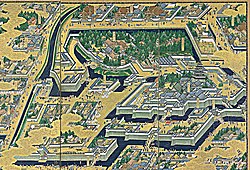
Back قلعة إيدو Arabic Замак Эда Byelorussian Kastell Edo Breton Castell d'Edo Catalan قەڵای ئێدۆ CKB Edo (hrad) Czech Edo-jō German Edo (kastelo) Esperanto Castillo de Edo Spanish Edoko gaztelua Basque
| Edo Castle 江戸城 | |
|---|---|
| Chiyoda, Tokyo, Japan | |
 Edo Castle with surrounding residential palaces and moats, from a 17th-century screen painting. | |
| Type | Flatland |
| Site information | |
| Controlled by | Imperial Household Agency |
| Condition | Mostly ruins, parts reconstructed after World War II. Site today of Tokyo Imperial Palace. |
| Site history | |
| Built | 1457 |
| Built by | Ōta Dōkan, Tokugawa Ieyasu |
| In use | 1457–present (as Tokyo Imperial Palace) |
| Materials | granite stone, earthwork, wood |
| Demolished | The tenshu (keep) was destroyed by fire in 1657, most of the rest was destroyed by another major fire on 5 May 1873. In use as Tokyo Imperial Palace. |
| Garrison information | |
| Occupants | Tokugawa shōguns, Japanese emperors and imperial family since the Meiji era |

Edo Castle (江戸城, Edo-jō) is a flatland castle that was built in 1457 by Ōta Dōkan in Edo, Toshima District, Musashi Province.[1] In modern times it is part of the Tokyo Imperial Palace in Chiyoda, Tokyo, and is therefore also known as Chiyoda Castle (千代田城, Chiyoda-jō). Tokugawa Ieyasu established the Tokugawa shogunate there, and it was the residence of the shōgun and the headquarters of the military government during the Edo period (1603–1867) in Japanese history. After the resignation of the shōgun and the Meiji Restoration, it became the Tokyo Imperial Palace. Some moats, walls and ramparts of the castle survive to this day. However, the grounds were more extensive during the Edo period, with Tokyo Station and the Marunouchi section of the city lying within the outermost moat. It also encompassed Kitanomaru Park, the Nippon Budokan Hall and other current landmarks of the surrounding area.[2]
- ^ "Map of Bushū Toshima District, Edo". World Digital Library. 1682. Retrieved 6 May 2013.
- ^ 熱海市教育委員会 (2009-03-25). "熱海市内伊豆石丁場遺跡確認調査報告書". Comprehensive Database of Archaeological Site Reports in Japan. Retrieved 2016-09-02.